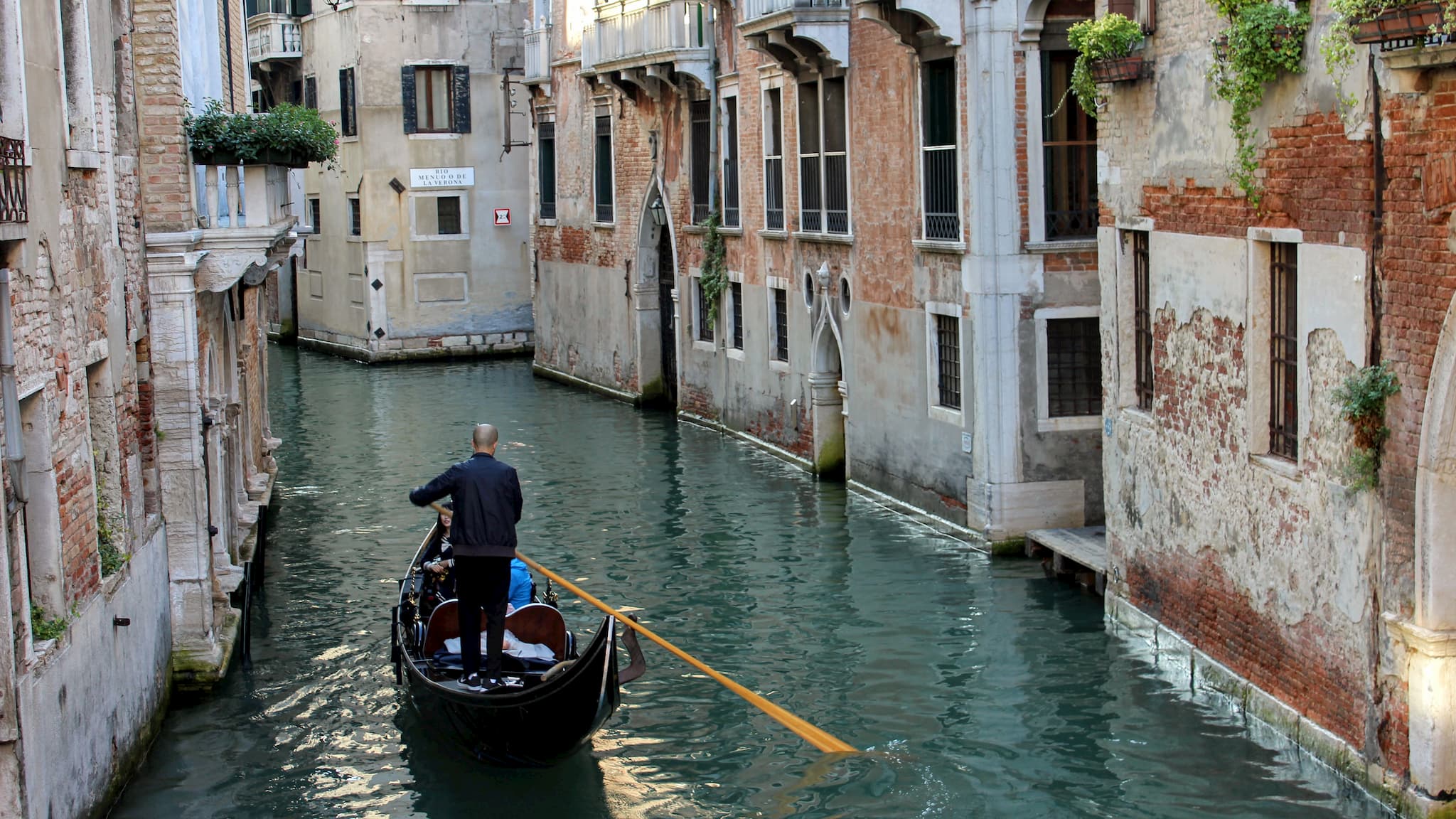
A Weekend in Venice
As a boy, I remember my grandmother telling stories of her and my grandfather’s trip to Italy. The two of them were invited by a sibling to go on the trip with most expenses paid. For some reason, the destination that I remember hearing about most vividly was Venice. I can still remember pictures of the canal with boats lined up and dozens of wooden poles sticking out of the water.
Since then the city has always been a place of wonder for me. What would it be like to live in a city navigated by boats? The island is located in a lagoon on the north-west coast of Italy and has been a major port for many years. The island’s isolated position helped protect it from attack until they became their own military power. As the population grew they learned how to build up multi-story houses right against the water, using every available piece of land. It is a truly unique place and one I was very glad we were able to visit.
We arrived in Venice late at night. We drove across the bridge which brings trains to the island or, in our case, cars to the parking garage. From there we took the ferry to meet our Airbnb host who would bring us to the apartment. From the ferry dock, she snaked through small pedestrian walkways while we lugged our suitcases over the stepped footbridges. The entrance to the apartment was down a small alley but the backside had a balcony sticking out into a small canal. We woke in the morning to the sound of motorboats and hired singers in gondolas.
St. Mark’s Square and Doge’s Palace
After catching up on sleep, we headed to St. Mark’s Square but our first attempt at navigating on our own didn’t go so well. We started off in the wrong direction and had to loop around to our destination. The square was bigger than I imagined. On three sides are two tiers of columns defining the square’s rectangular outline and hiding small shops and restaurants behind them. At the far end from where we entered was St. Marks Basilica and to our right stood a 99 meter high “campanile” or tower.
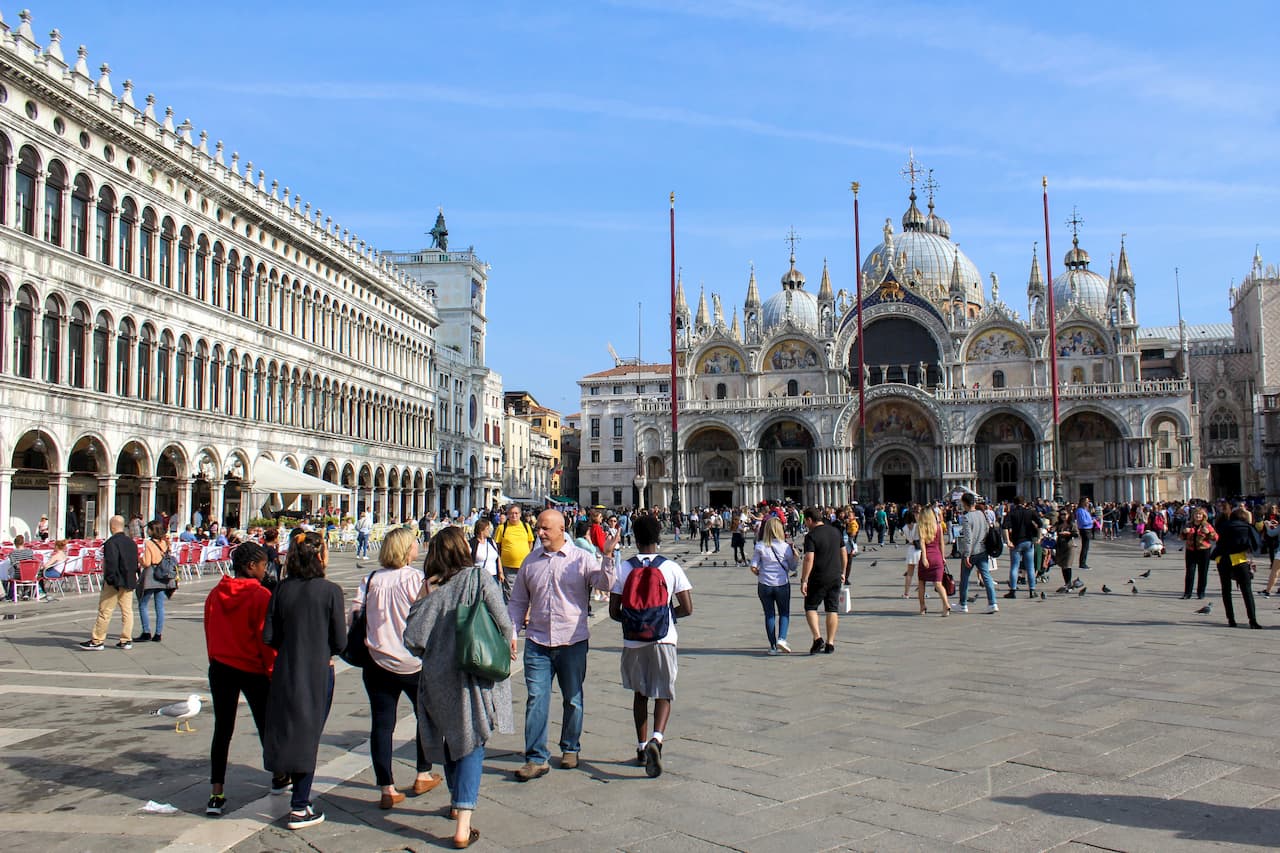
When we arrived, the square was busy with people. Some of them were taking pictures with tripods, others were feeding the pigeons and gulls despite the signs telling people not too. The birds were unnaturally bold. Pigeons rested on people’s arms. One of the gulls knocked food out a boy’s hand. The square was completely dry while we were there allowing us to appreciate the musicians playing for the patrons of the square’s restaurants but at high tide the area is known to flood so there were platforms stacked up that can be organized into walkways.
As we made our way to the far end we got a better view of the basilica. The face of it is decorated with mosaics and gold leaf. Up on the balcony stand 4 large horses. The originals, which now sit inside the cathedral, were brought to Venice from Constantinople. Napoleon later brought the horses to Paris but less than two decades later they were returned to Italy until they were finally taken down to protect them from local pollution. Entrance to the Basilica is free, however, we bought tickets to Doge’s Palace.
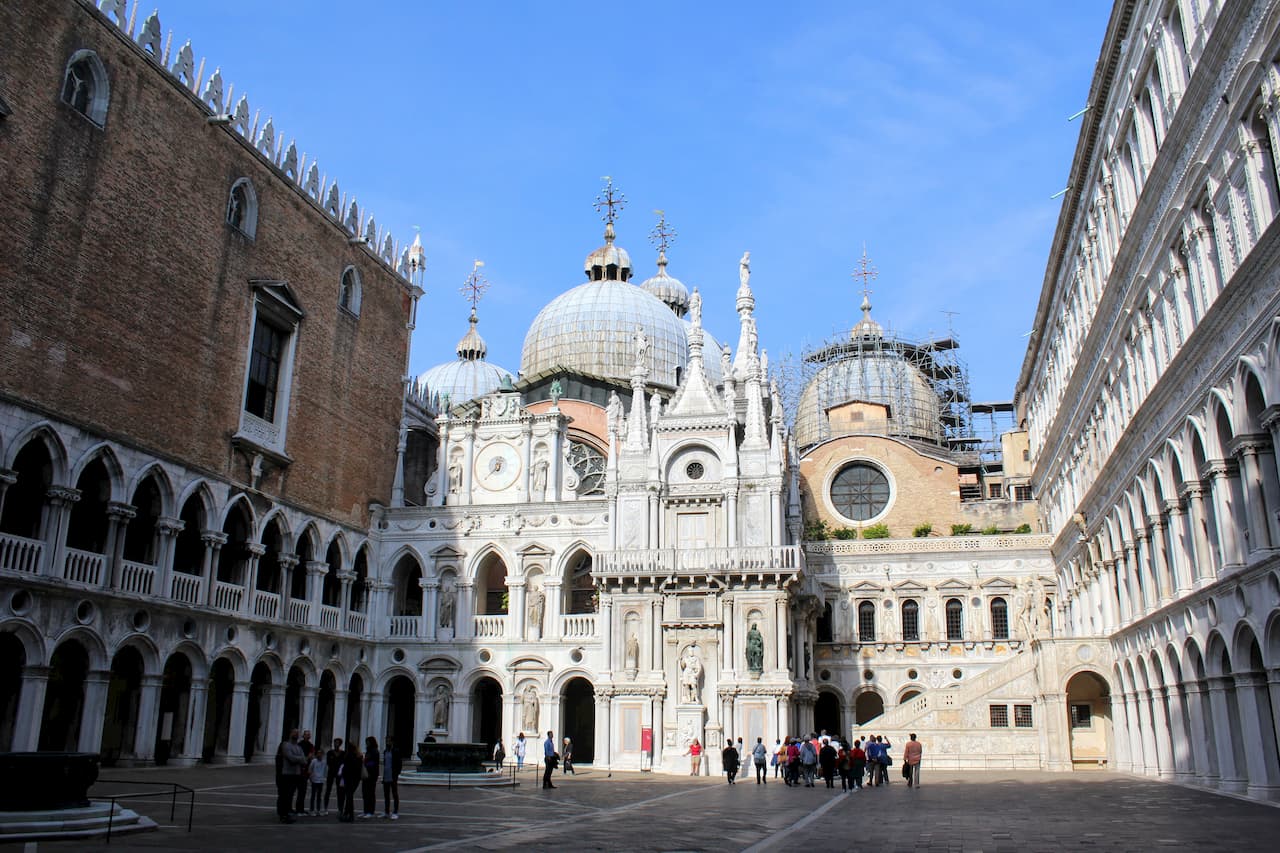
The Doge was the ruler of the Venetian city-state and the palace was as much a government building as it was a residence. There many councils used the building to make decisions. Compared to the colors and gold leaf of the basilica, I wasn’t immediately impressed by the white columns of the palace exterior. However, as I got closer I realized everything about the building is intricately decorated. The entrance is flanked by marble columns with detailed carvings which leads to a staircase topped with a finely decorated ceiling. The rooms are decorated with elaborate wood trim, gold leaf, and enormous paintings. Each council had a room with a uniquely themed collection of paintings. Some of the rooms show mythological stories of the ancient gods. Others are painted with biblical themes. However, many of the largest paintings, like those in the great hall, are stories of Venice and its military might.
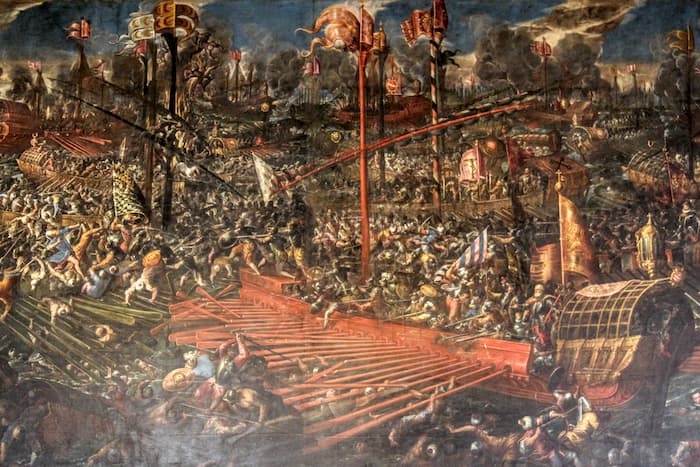
The interior of the palace now houses a museum. One of the exhibits showed paintings from around Europe at the time of Venice’s great power. Antwerp Belgium was a major rival port to Venice at the time and artists exchanged ideas between the two cities. It was interesting to see what this part of the world was like at the time the palace was used. There were musical instruments, portraits, clothing, and intricate Venetian glassware. The museum also included a tour of the armory, which showed an array of Venetian weapons like spears, swords, and crossbows used by the Venetian army and navy.
From inside the palace, you can cross over the enclosed “Bridge of Sighs” which takes you into the jail just across a small canal from the palace. There were at least 3 floors of the jail with about 8 large empty cells per floor. They were dark and cold and confusing to navigate. At one point I got separated from the group and had to loop back to find everyone. I can’t imagine how intimidating it would be to be thrown into one of those cells after appearing before a counsel in the palace.
I think touring the palace helped me see the part of Venice that once was a thriving commercial city and regional power. The buildings are all tourist attractions now but they once were very functional, if still decadent, facilities. The surrounding area of the square is a must-see for anyone visiting Venice for the first time. Even just walking the shoreline is fun but there are lots of shops and restaurants around the square. On our way back it turned out we were only about 8 blocks from the square when walking directly so we passed by the square a couple time later in the trip.
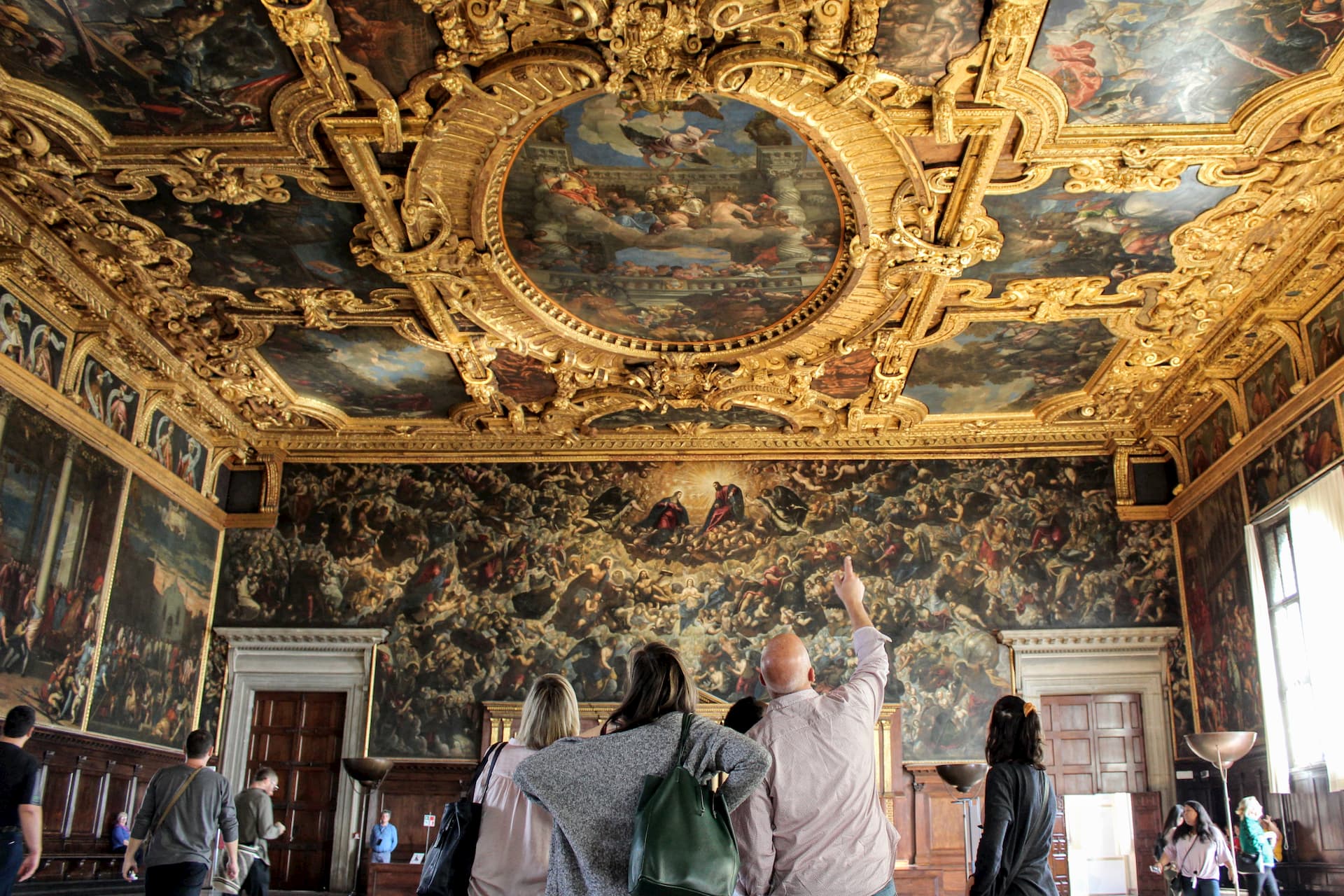
Murano and Burano
The lagoon surrounding Venice is filled with similar islands, each with its own culture and identity. We visited two of these islands using the local ferry. Unfortunately, we had to wait about an hour in line just to get our ferry tickets. Once we had our tickets, we took a 28-minute ferry from the northern side of Venice, passing by a square cemetery island, and getting off at the first stop on Murano. This island is known for its expert glassblowers as was visible in a workshop a few steps away from the ferry stop.
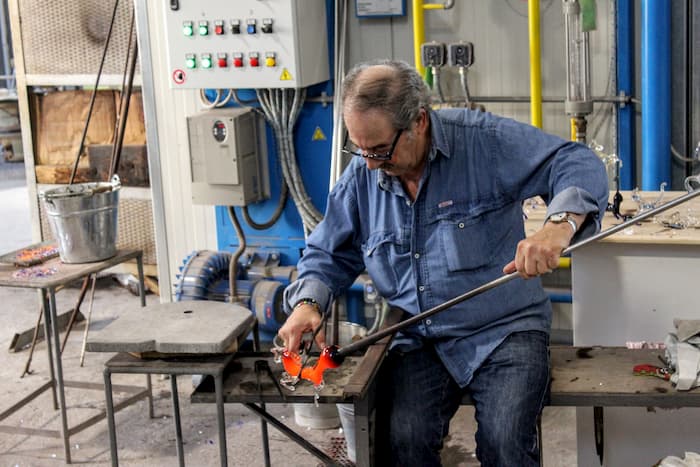
We entered the workshop for a small fee to see a demonstration by three glassblowers. One of the glassblowers worked with pliers to take a large, glowing-hot ball of glass and make it into a horse in less than two minutes. It was impressive to see how quickly he made the piece, working from the head to the tail and rotating the pipe to keep it from folding over. The other two artisans worked with torches. One of them seemed to be making some kind of jewelry while the other made shot glasses. An interesting technique they both used was taking thin, metal foil and working it into the glass to change the color.
From the shop we walked through several stores on the island, traveling along the canals. The stores had glass pieces ranging from figurines to chandeliers. It was fun to see the creativity in all the different pieces, though most shops seemed to be selling the same kinds of items. The island is fairly big and you can see that parts of it are getting run down as the economy has shifted to tourism.
From Murano, we took a 45-minute ferry further north to the island of Burano. The ferry came about every 15 minutes however there were so many people that it took two boats for us to finally get on. This ferry passes by some interesting waterways with piers showing the deeper sections and some kind of lanes defined with smaller poles off to the side. There is also a marshy area with no buildings on it and a few small islands occupied by single large buildings. It made me realize how shallow parts of the lagoon are.
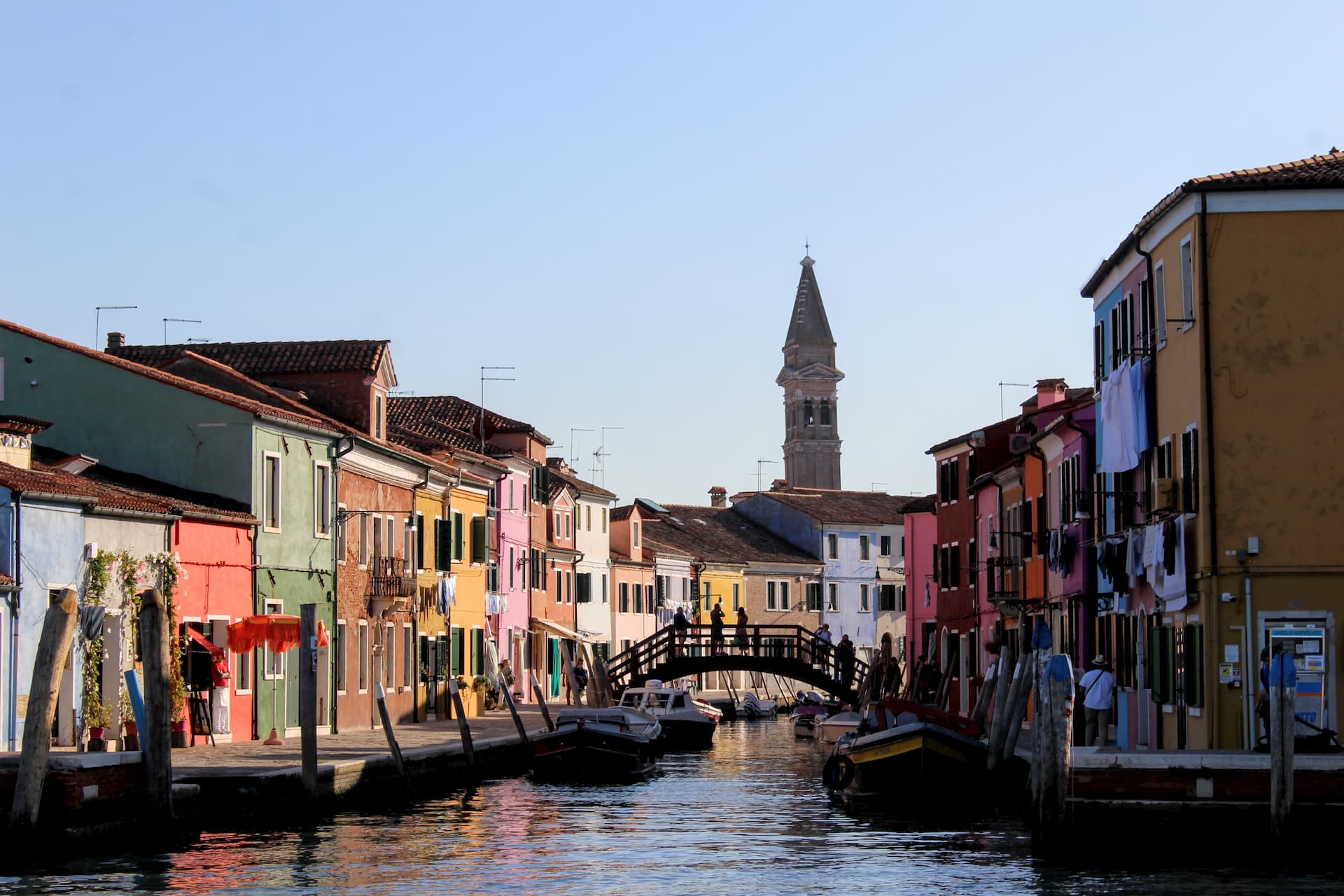
Burano is known for its colorful houses. The story goes that the native fishermen paint their houses vibrant colors so they can easily identify their home when they return at the end of the day. You can tell that the island is more residential than Venice because people were driving boats or taking care of their homes as we walked around. It was fun seeing a few elderly residents sitting outside their homes watching the tourists walk by while calling out to their neighbors across the street. For us, the island was a really fun place to take pictures and explore. The colorful homes, waterways with docked boats, and leaning clock tower, made for a really unique setting. I liked that there were more trees and greenspace there too. The island of Mazzorbo across the bridge had a whole vineyard complete with sculptures. However, the prices at the restaurants were significantly higher than Venice so we caught a ferry back to the main city as the sun was going down.
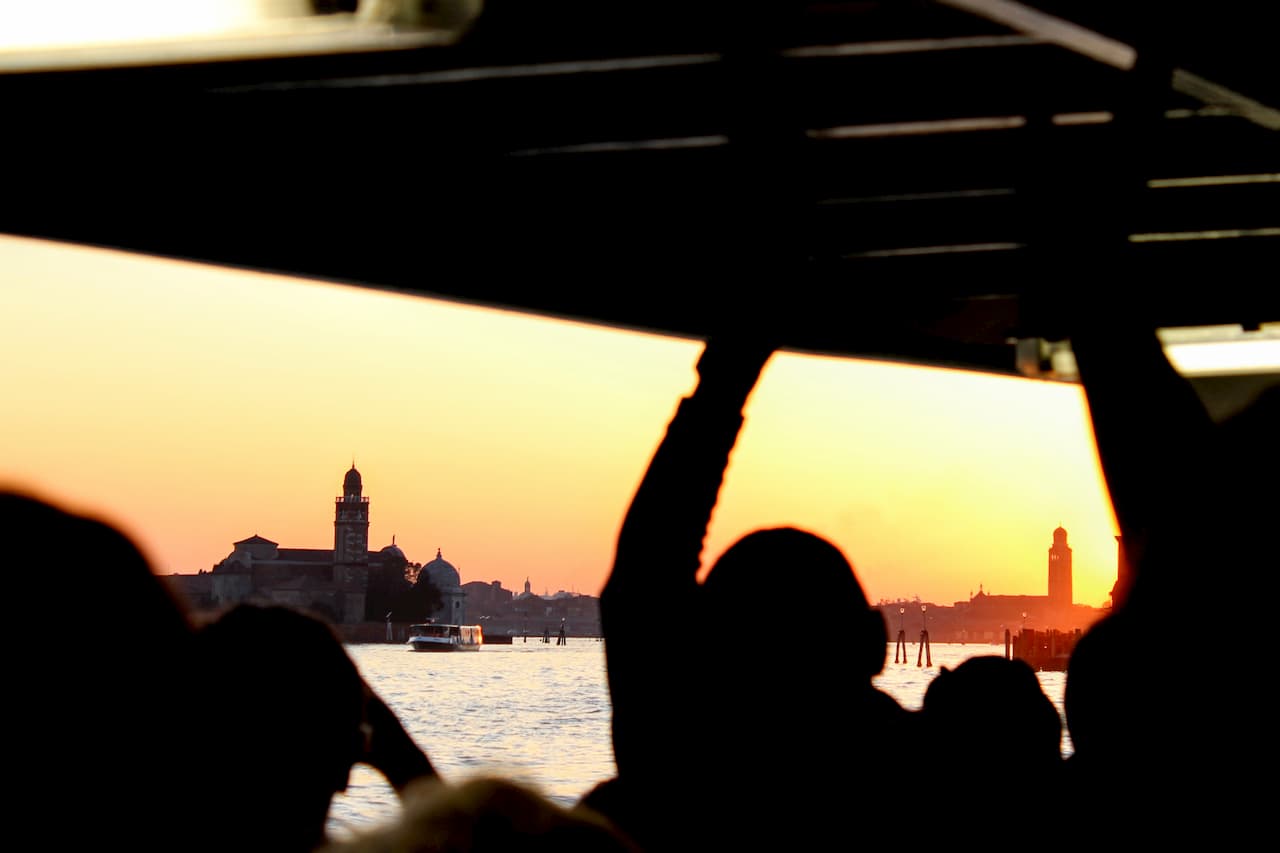
Food
With its narrow streets, Venice was a busy place to walk around in the evenings. There were lots of high-end stores next to butcher shops and old restaurants. During our stay, we celebrated my parent’s anniversary. While they went out to dinner, we made dinner with my siblings from food we bought at a grocery store off the grand canal. Afterward, we all watched the 2003 movie “The Italian Job” which has its opening scene set in Venice, including St. Mark’s Square which we had seen earlier. The filmmakers had to get special permission to perform a boat chase through the canals of Venice. It was a fun night with my family and more laid back than trying to find a restaurant that had room for our large group.
There are plenty of great places to eat all over the city. For lunch, we usually had pizza or sandwiches. One day for breakfast I ordered an apricot jam crepe while we were walking down the street. For dinner, we tried a couple new dishes including a risotto and squid ink pasta. The squid ink pasta is a special dish where the pasta is mixed with cuttlefish ink, making the pasta (and your teeth) black. We had seen it a couple other places so I wanted to give it a try. Unfortunately, it wasn’t very flavorful; somewhat creamy, but with a little fishy flavor. Still, it was a fun culinary experience. After several of our dinners, the restaurants gave our large group shot glasses of limoncello which was a nice way to end the meal.
Lastly, there was the gelato. Just two blocks from our apartment was a gelato place that we visited a couple of times during our stay called Fantasy Gelato. It was nice to be able to grab a dessert after dinner without having to walk too far. One night I decided to try a milkshake. They blended it entirely too long and the milkshake was too liquefied but it was still refreshing. The most unique flavor we had was a rum-flavored ice cream which was really tasty.
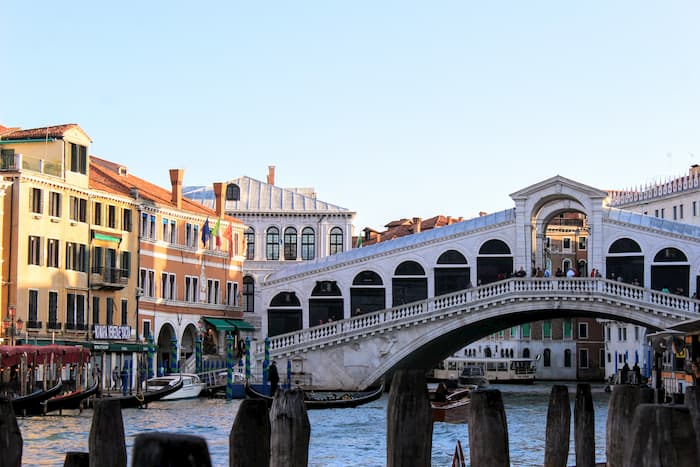
Venice exceeded my expectations and is a fascinating city to visit. It takes a little getting used to the streets but it isn’t too hard to get around. Bekah and I took one morning to explore the city ourselves and visited two of the most famous bridges spanning the Grand Canal that runs through the heart of the city. The Rialto Bridge is a white stone bridge that arches across the canal. We were there early in the morning as the row of shops in the middle were just opening. We also walked across the Ponte dell’Accademia which is named for the art academy which was housed at one side. The wooden bridge was originally a temporary structure in 1933 but has survived to become a permanent structure. You could hear the wood creak as people walked across, amplifying the feeling of being high in the air as we looked out on the opening of the canal.
The other fun place we walked around was the southern coast of the Castello neighborhood out past St. Mark’s Square. The coastline has beautiful views and there are a few small parks on the edge the island. One small park had a collection of international sculptures on display. As we walked around a loud European Robin flew back and forth, keeping an eye on us. Another park had a small koi pond filled with turtles. It was a beautiful place to walk around and one of the few places that felt like we were walking on solid ground.
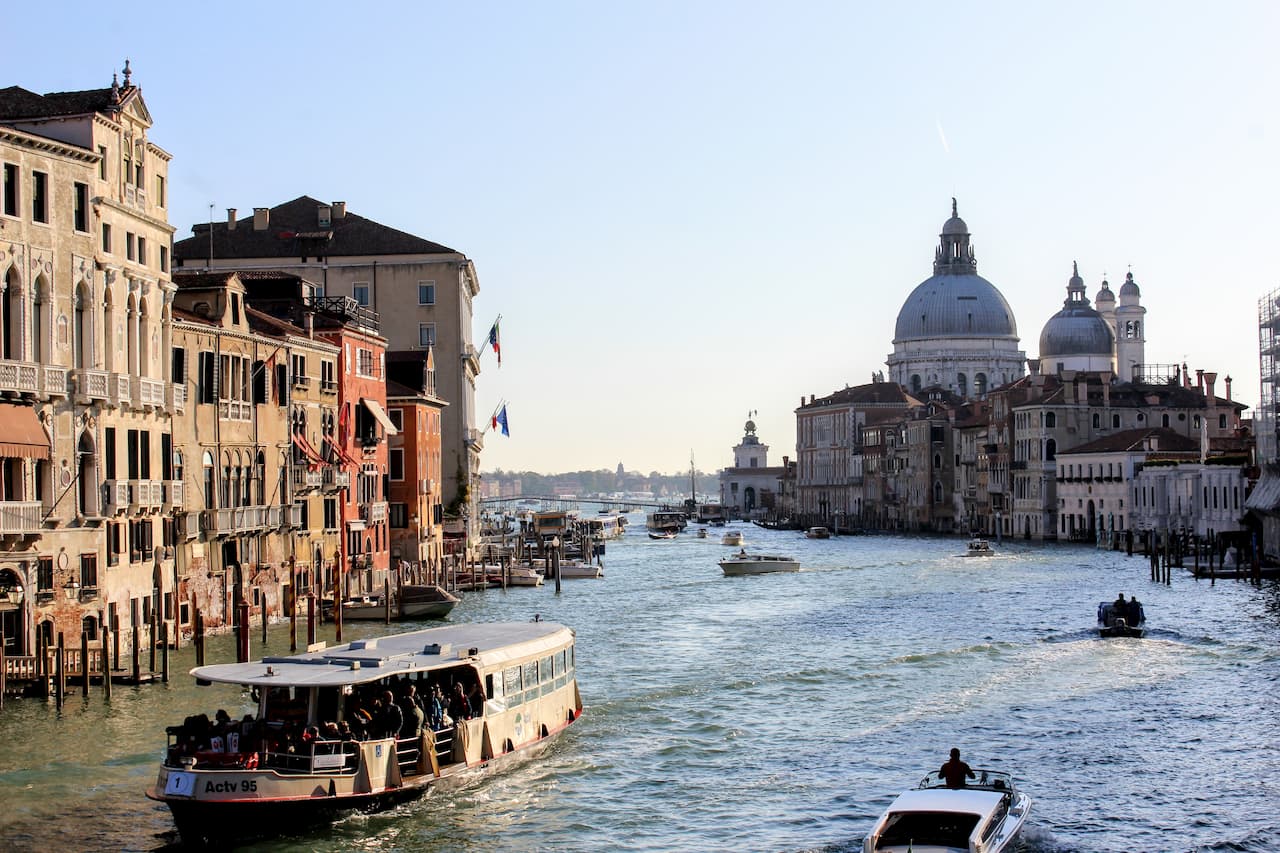
Life in Venice seems completely bound to the hoards of tourists that visit each year. From the walkway along the edge of the city we saw huge cruise ships pass by. We loved the restaurants and leather shops that lined the streets but living there year-round seems incredibly expensive. Though it is a tourist staple, Bekah and I opted not to pay the $100+ for a gondola ride. We were content to watch the finely decorated boats take people through the narrow canals as they recorded their experience with their selfie-sticks.
Seeing Venice was one of my favorite parts of the trip. While our other destinations in Italy were relaxing or informative, walking through Venice was living a childhood dream. It was a great way to end our trip and a fun place to explore with family. Our exit from Italy involved one more ferry ride to Venice Marco Polo Airport on the mainland. Bekah and I carried our suitcases through the empty stone streets early in the morning to the boat that would take us directly to the airport entrance and out of Italy.
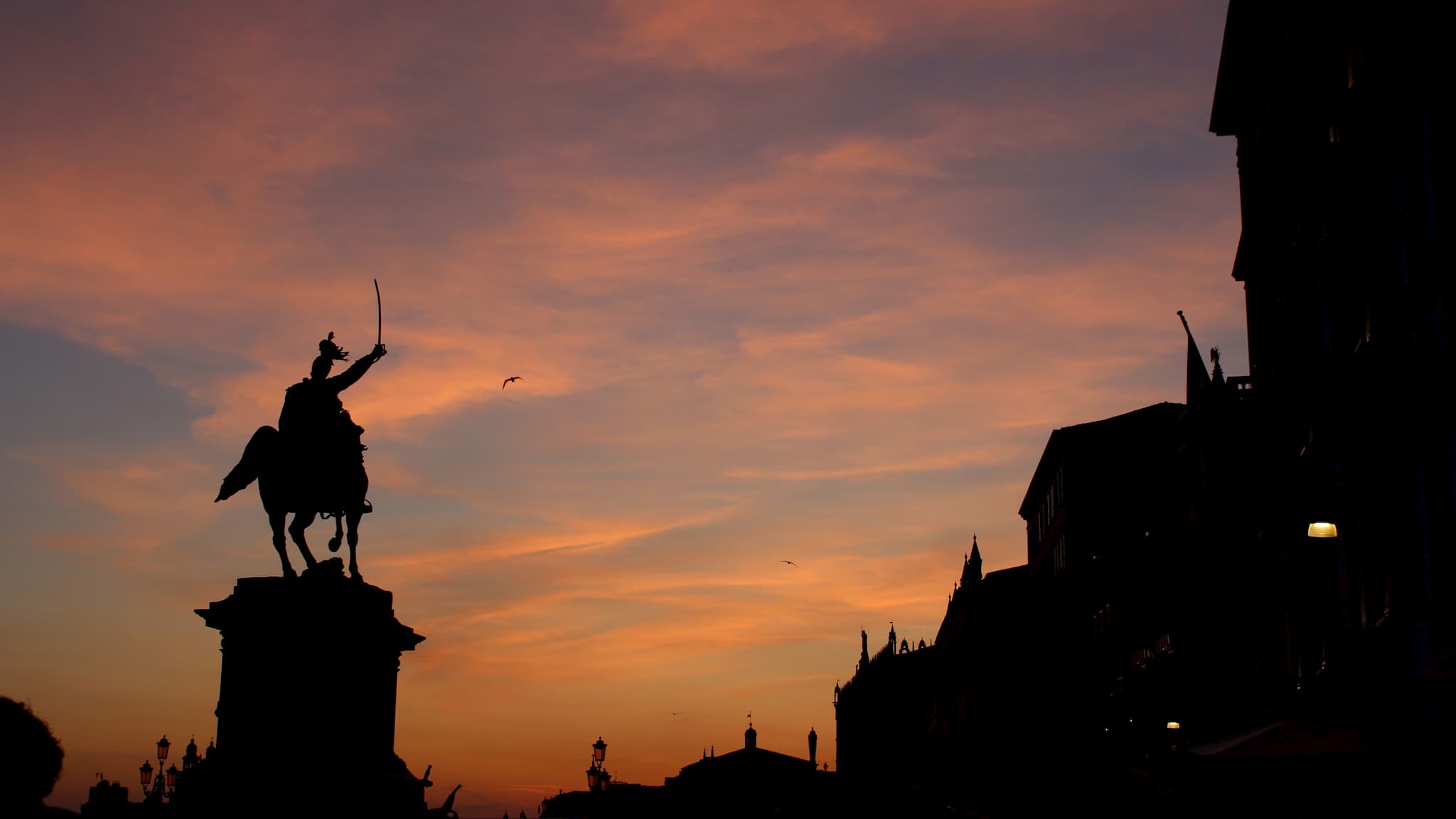
See how to respond...
Respond via email
If you'd prefer to message me directly, send an email. If you'd also like your message to be visible on the site I can add it as a comment.
Reply via Email
Respond from another site
Responses are collected from posts on other sites. Have you posted somewhere that links to this page? If so, share the link!